

Contextual Learning Definition - Center for Occupational Research and Development. What is the best way to teach so that all students can use and retain information?
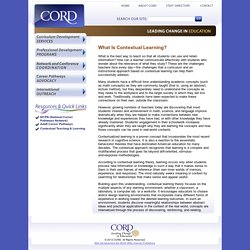
How can a teacher communicate effectively with students who wonder about the relevance of what they study? These are the challenges teachers face every day—the challenges that a curriculum and an instructional approach based on contextual learning can help them successfully address. Many students have a difficult time understanding academic concepts (such as math concepts) as they are commonly taught (that is, using an abstract, lecture method), but they desperately need to understand the concepts as they relate to the workplace and to the larger society in which they will live and work. Traditionally, students have been expected to make these connections on their own, outside the classroom. Contextualized learning is a proven concept that incorporates the most recent research in cognitive science. Redirect Notice. Contextual learning. Contextual learning has the following characteristics: emphasizing problem solvingrecognizing that teaching and learning need to occur in multiple contextsassisting students in learning how to monitor their learning and thereby become self-regulated learnersanchoring teaching in the diverse life context of students[clarification needed]encouraging students to learn from each otheremploying authentic assessment[clarification needed] Key Elements[edit] Current perspectives on what it means for learning to be contextualized include.

Kinesthetic Learning. Kinesthetic learning occurs as students engage a physical activity: learning by doing, exploring, discovering.

Kinesthetic learning is one of four learning styles defined by Neil Fleming and co-workers (see Fleming, N., and Mills, C., 1992, Not Another Inventory, Rather a Catalyst for Reflection,Published in: To Improve the Academy, Vol. 11, Page 137): visual, auditory, reading/writing, and kinesthetic. (Have your students take the VARK Survey (more info) to see what their learning preferences are!). Antecedents and consequences of employee engagement. Define make.
Qualitative Quantitative. By Saul McLeod published 2008 Research methods and research data in psychology can be placed into two basic categories: quantitative or qualitative.
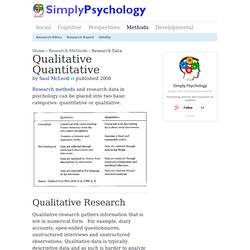
Qualitative Research Qualitative research gathers information that is not in numerical form. For example, diary accounts, open-ended questionnaires, unstructured interviews and unstructured observations. Qualitative research is useful for studies at the individual level, and to find out, in depth, the ways in which people think or feel (e.g. case studies). Finding Flow: The Psychology of Engagement with Everyday Life - Mihaly Csikszentmihalyi. Www.sva.org.uk/shadow/resources/brook-isis.pdf. The Importance of Recognizing Tactual and Kinesthetic Learners. Young children learn by touching, feeling, moving, and experiencing.
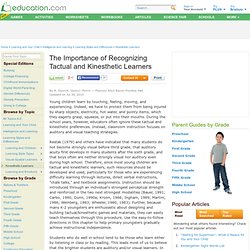
Indeed, we have to protect them from being injured by sharp objects, electricity, hot water, and pointy items, which they eagerly grasp, squeeze, or put into their mouths. During the school years, however, educators often ignore these tactual and kinesthetic preferences. Instead, classroom instruction focuses on auditory and visual teaching strategies. Restak (1979) and others have indicated that many students do not become strongly visual before third grade, that auditory acuity first develops in many students after the sixth grade, and that boys often are neither strongly visual nor auditory even during high school. Therefore, since most young children are tactual and kinesthetic learners, such resources should be developed and used, particularly for those who are experiencing difficulty learning through lectures, direct verbal instructions, "chalk talks," and textbook assignments.
Common Core Doodling. How Doodling Makes Your Brain Work Better, and What This Means for Your Students As the Common Core continues to roll out all over the country, teachers are looking for new ideas, and new ways to engage students in learning.
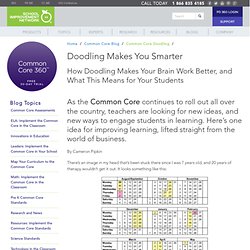
Here’s one idea for improving learning, lifted straight from the world of business. By Cameron Pipkin There’s an image in my head that’s been stuck there since I was 7 years old, and 20 years of therapy wouldn’t get it out. It looks something like this: I blame it all on Ms. Now, as an adult, when everything revolves around a January – December calendar, Ms. Can Doodling Improve Memory and Concentration? An experiment suggests doodling may be more than just a pleasant waste of time and paper.
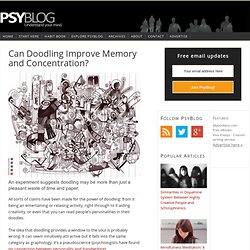
All sorts of claims have been made for the power of doodling: from it being an entertaining or relaxing activity, right through to it aiding creativity, or even that you can read people’s personalities in their doodles. The idea that doodling provides a window to the soul is probably wrong. It can seem intuitively attractive but it falls into the same category as graphology: it’s a pseudoscience (psychologists have found no connection between personality and handwriting). Although it’s probably a waste of time trying to interpret a doodle, could the act of doodling itself still be a beneficial habit for attention and memory in certain circumstances? To test this out Professor Jackie Andrade at the University of Plymouth had forty participants listen to a mock answerphone message which was purportedly about an upcoming party (Andrade, 2009). Crucially, these participants were pretty bored. Analysis of Development Needs and Learning Styles - by Raheemshareefm.
Analysis of development needs and learning styles Effective learning is an essential component of business strategy.
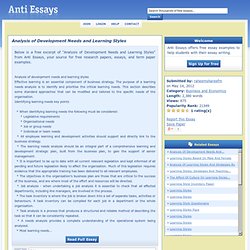
The purpose of a learning needs analysis is to identify and prioritise the critical learning needs. This section describes some standard approaches that can be modified and tailored to the specific needs of the organisation. Learning Styles - Learning skills from MindTools. Understanding Learning Preferences Identifying your preferred style of learning can make gaining new knowledge and skills easier.

Have you ever tried to learn something fairly simple, yet failed to grasp the key ideas? Or tried to teach people and found that some were overwhelmed or confused by something quite basic? If so, you may have experienced a clash of learning styles: your learning preferences and those of your instructor or audience may not have been aligned. When this occurs, not only is it frustrating for everyone, the communication process breaks down and learning fails.
Www.usma.edu/cfe/Literature/Workman_12.pdf. Theory of multiple intelligences. The theory of multiple intelligences is a theory of intelligence that differentiates it into specific (primarily sensory) "modalities", rather than seeing intelligence as dominated by a single general ability.
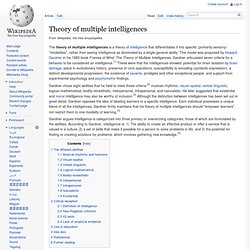
This model was proposed by Howard Gardner in his 1983 book Frames of Mind: The Theory of Multiple Intelligences. Gardner articulated seven criteria for a behavior to be considered an intelligence.[1] These were that the intelligences showed: potential for brain isolation by brain damage, place in evolutionary history, presence of core operations, susceptibility to encoding (symbolic expression), a distinct developmental progression, the existence of savants, prodigies and other exceptional people, and support from experimental psychology and psychometric findings.
Gardner argues intelligence is categorized into three primary or overarching categories, those of which are formulated by the abilities. The different abilities[edit] Student Learning Preferences and Teaching Implications. © 2004 American Dental Education Association + Author Affiliations Direct correspondence and requests for reprints to Mr. Robert J. Murphy, Department of Pathology and Laboratory Medicine, Temple University Hospital, Broad Street, Philadelphia, PA 190140; 215-707-3466 phone; 215-707-2053 fax; murphyrj@tuhs.temple.edu. Received March 11, 2004. Cognitive styles and learning strategies: Understanding style differences in learning and behaviour. March 2002 — Volume 5, Number 4 Richard Riding & Stephen Rayner, (1998) London: David Fulton Publishers. Pp. 217 ISBN 1-85346-480-5 (paper) US $ 29.95. Learning styles. Learning style is an individual's natural or habitual pattern of acquiring and processing information in learning situations.
A core concept is that individuals differ in how they learn.[1] The idea of individualized learning styles originated in the 1970s, and has greatly influenced education.[2] Proponents of the use of learning styles in education recommend that teachers assess the learning styles of their students and adapt their classroom methods to best fit each student's learning style. Although there is ample evidence for differences in individual thinking and ways of processing various types of information, few studies have reliably tested the validity of using learning styles in education.[2] Critics say there is no evidence that identifying an individual student's learning style produces better outcomes. David Kolb's model[edit] David A. Kinesthetic learning.
Kinesthetic learning (also known as Tactile learning) is a learning style in which learning takes place by the student carrying out a physical activity, rather than listening to a lecture or watching a demonstration. People with a preference for kinesthetic learning are also commonly known as "do-ers". Tactile-kinesthetic learners make up about five percent of the population.[1] The Fleming VAK/VARK model (one of the most common and widely used categorizations of the various types of learning styles)[2] categorized learning styles as follows: History[edit] Kinesthetic intelligence was originally coupled with tactile abilities, and was defined and discussed in Howard Gardner's Frames Of Mind: The Theory of Multiple Intelligences.
In his book, Gardner describes activities (such as dancing and performing surgery) as requiring great kinesthetic intelligence: using the body to create (or do) something. Characteristics[edit] Learning style learning disability. Learning Disabilities vs. Learning Styles. Written by Sheldon H. Horowitz, EdD. Eprints.lancs.ac.uk/61685/1/Deliverable_3_Student_Engagement_toolkit_for_leaders.pdf.
Www.craftscouncil.org.uk/files/download_iterator/44e4ed29b74aab60/benefits-of-craft-to-learners-summary.pdf. Www.craftscouncil.org.uk/files/download_iterator/44e4ed29b74aab60/benefits-of-craft-to-learners-summary.pdf. Herbert Benson. Herbert Benson, M.D. (born 1935), is an American cardiologist and founder of the Mind/Body Medical Institute at Massachusetts General Hospital in Boston.
Cognitive benefits of crafts for all ages - San Antonio child development. Craft activities develop fine motor skills, problem solving, and increase cognitive ability. Manufacturing sector’s untapped potential can lift us out of recession. THE government claimed a “march of the makers” would drive Britain out of recession. Fast-forward a few years, and it might just be becoming a reality.
Figures last week showed UK manufacturing is on the up – rising at its highest pace since the end of 2010. Overall output rose by 1.9 per cent in June, following declines in both May and April, while industrial production jumped 1.1 per cent. This increase, and a rise in export orders, have pushed the Markit/CIPS manufacturing purchasing managers index (PMI) up to 60.2 in July from 56.9 in June.
The latest statistics suggest that Britain is on the mend. Demand for UK manufactured goods remains strong, but if the government is to meet its exporting targets, it must reach out to international partners. Events like next year’s International Festival for Business – for which I am an ambassador – can give Britain’s small businesses the encouragement they need to start operating internationally.
Learn the health and financial benefits of crafting at WomansDay. Amidst all the often dire economic reports of the last couple of years has come some happy news: There's been a resurgence in crafting. Stores that sell craft supplies not only have been among the least affected by cutbacks in spending but also have often seen increased sales.